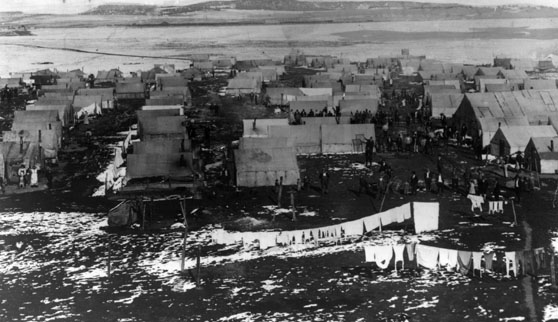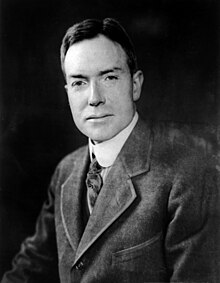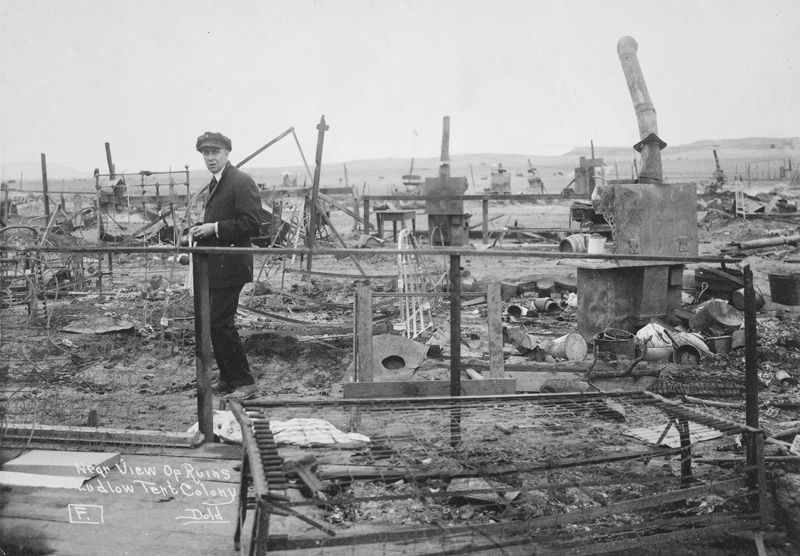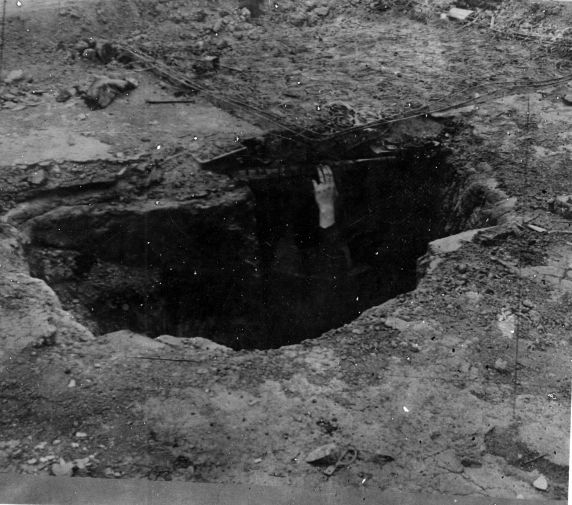A Bad Day In Colorado

Ludlow
An abundance of accessible coal and the creation of rail lines to bring the product to market, the coal industry explodes in Colorado after the Civil War ... at its peak in 1910 it will give work to thousands and create 10% of the jobs in the state. Consolidated into the hands of a few, the largest operator in the industry is Colorado Fuel and Iron (CF&I), a company controlling 71,837 acres of the state run by one of the wealthiest men in the country, John D. Rockefeller, Jr., from his high aerie at his New York City office on Broadway, over 2,000 miles away (a birthday present Senior gives Junior in 1909), with other powerful players in the region being the Rocky Mountain Fuel Company, and Victor-American Fuel Company. Dangerous work for the hands-on colliers, explosions, collapsing mines, and suffocation cause an industry that loses 3.15 men for every 1,000 employed, but the rate is even worse in Colorado where 10 men forfeit their lives for every 1,000 that toil in the mines while living in corporate towns where all real estate (shacks sometimes occupied by twenty people or more) and amenities are controlled by the coal companies (more than 1,700 miners will lose their lives in the state between 1884 and 1912). Concerns over safety and pay ignored, without a political voice, the coal workers (an international work force composed of men of English and Scots-Irish descent, and workers from distant locales like Greece, Japan, and Serbia) increasingly turn to unions for the protection of their rights, and there are strikes in Colorado in 1884, 1894, and 1904. Seeking shelter under the labor umbrella of the United Mine Workers of America (UMV), in 1913, Colorado's colliers ask for union representation in future collective bargaining, an adjustment down in the tonnage compensation rate for digging coal, enforcement of the state's eight-hour work day laws, payment for work that doesn't involve digging coal out of the mines, weight checkers to be chosen by the workers, mitigation of company town policies, and an end to the company guard system of workman intimidation. Demands rejected, after a fiery speech during a local rainstorm by Irish-born schoolteacher and dressmaker turned union activist, Mary G. Harris Jones (Mother Jones to history, in her speech she will exclaim, "Rise up and strike! If you are too cowardly, there are enough women in this country to come in a beat the hell out of you. When we strike, we strike to win!" ... unhappy with her words, authorities put her in the Trinidad jail for twenty days), over 20,000 colliers strike on September 23, 1913.
Senior

Junior

Jones

Ludlow Strikers
Escalating towards tragedy, CF&I responds by evicting the strikers and their families from company owned housing (the workers will in turn create tent cities near the mines being struck, one of the largest is the Ludlow site near Trinidad of roughly 120 tents and 1,200 people), strike breakers are brought in, and "security" personnel are hired from the Baldwin-Felts Detective Agency (said to be comprised of "... Texas desperadoes and thugs" ... upon arrival in the area, many are immediately deputized as county sheriffs), that employ the unusual protective activity of driving about the camp in a specially made armored car from nearby Pueblo that sports a machine gun called the "Death Special"). And answering to the powers that provide his political funding as strike related violence escalates, Colorado Governor Elias Milton Ammons calls out the state's National Guard (led by General John Chase) to patrol the striking region (paid for from the deep pockets of Junior, the militia is at first welcomed by the strikers). Catalyst for catastrophe, when strikebreaker Neil Smith is found murdered on March 8, 1914, near the striking colony of Forbes, Colorado, the National Guard turns its full attentions on the Ludlow colony, where the killer is presumed to be hiding and decides to go find the culprit (additionally, insults and spit are exchanged on April 19, 1914, between women of a union aligned baseball squad and members of the Guard, one of whom states, "Go ahead, have your good time today, and tomorrow we will get your roast.").

The "Death Special"

Ammons

Chase
Death At Forbes
The powder keg finally explodes the day after the Ludlow colony celebrates the Easter Sunday of the Eastern Orthodox Church. On Monday morning, three guardsmen come to the camp and demand the release of a man they say is being held by the strikers. Interested in preserving the peace of the spring morning, the camp's leader, Louis Tikas agrees to meet on the issue with Major Patrick J. Hamrock at the nearby Ludlow railroad depot. While there, to the jeers of the strikers and their families, guardsmen set up two machine gun positions overlooking the camp. Weaponry too enticing not to use, in the exchange of lead that soon begins between the antagonists, both sides point the finger at the other for being the first to fire ... and in the chaos that ensues, no one will ever know now. For the rest of the day the two sides fire on each other with some strikers fleeing into the nearby hills, while others hide in pits dug specifically to keep tent families from being targeted. Leaderless after Tikas has a rifle butt broken over his head by Lt. Karl Linderfelt and is then murdered by being shot in the back three ties, when gunfire from the camp dies down as the colliers run out of ammo, the guardsmen leave their defensive positions to loot and torch the colony (a pumpman for the Colorado & Southern Railroad named M. G. Low will become a hero when he moves a train engine to block the rounds of one of the machine guns). By 7:00 in the evening, the tent city is in flames and the carnage begins to be analyzed (the bullet back and forth lasts ten hours) ... on the company side of the ledger, Rockefeller loses three company guards and one guardsman, while the strikers take losses to the men, women, and children of Ludlow to the tune of between 21 and 55 deaths (with the press selling papers telling the tale of a camp infirmary cave in which two women and eleven children will suffocate to death, the youngest, Elvira Valdez is only three months old).

Tikas
Machine Gun Position
The National Guard
After

Carnage

The Death Pit

The Costa Family - Four, Including Both Parents, Will Die On 4/20/1914

Services For The Dead
Tikas Funeral Procession
Enraged at what has taken place, the next day the strikers rearm themselves and begin a guerilla campaign against the company towns and mines of Colorado's southern coal fields along a 221-mile front from the town of Trinidad to the town of Louisville which will become known as the Ten Day War ... ten days more of carnage in which there will be more deaths (the final count for the Colorado Coalfield War is somewhere in the neighborhood of 169), mines in the towns of Berwind, Tabasco, and McNally are seized by the strikers, the coal mines of Aguilar and Walsenburg are completely destroyed, a band of roughly 1,000 Greeks, Italians, Slavs, and Mexican miners take the town of Forbes from a force of state militia, mine officials, and hired strikebreakers, and armed colliers take a victory parade over the streets of Trinidad. Ten days that also finally gets the Federal government involved in the strike as Congress begins investigating the massacre and President Woodrow Wilson declares a state of emergency and sends in Federal troops to squelch the violence. As if the war had never happened (it is estimated that the strike costs $18 million (converted to 2019 standards, a sum of $459,448,505, almost half a billion dollars), both sides disarm and face the consequences of their actions ... 400 miners are arrested and 332 are charged with murder, but only one, John Lawson is found guilty and sentenced to life in prison, a sentence which the Colorado Supreme Court soon shoots down on the technicality that the state never declared martial law in their push to end the strike. Opposite those judgments, 22 guardsmen, including 10 officers are court martialed (they will all be acquitted and Junior will crazily contend that no massacre at all took place and the guardsmen were merely protecting themselves from a superior force), with Major Hamrock found not guilty of murder, and Lt. Linderfelt receiving responsibility for the murder of Tikas in a killing the military court finds warranted.

Area Of The Conflict

Lawson
Hamrock

Linderfelt
Public sentiment on the side of the strikers after the massacre (the strike is officially called off on December 10, 1914), after Congress reports on the incident in 1915, the union is not recognized and many strikers are replaced and never work their jobs again, however, they are instrumental in promoting new child labor laws and seeing the institution of an eight-hour work day (and the CF&I does improve its colliers working conditions, improving safety standards and health requirements, while building recreational areas and paved roads through the area). Over a hundred years in the past now, the massacre still serves as a rallying cry for labor ... the massacre site is now a ghost town owned by the UMW and is designated as a National Historic Landmark on January 16, 2009. And lest it be forgotten despite numerous books, magazine articles, plays, operas, and movies on the subject, the incident forms the bones of the poetry for one of Woody Guthrie's rousing works of folk song protest, 1944's "The Ludlow Massacre:"
It was early springtime when the strike was on,
They drove us miners out of doors,
Out from the houses that the Company owned,
We moved into tents up at old Ludlow.
They drove us miners out of doors,
Out from the houses that the Company owned,
We moved into tents up at old Ludlow.
I was worried bad about my children,
Soldiers guarding the railroad bridge,
Every once in a while a bullet would fly,
Kick up gravel under my feet.
Soldiers guarding the railroad bridge,
Every once in a while a bullet would fly,
Kick up gravel under my feet.
We were so afraid you would kill our children,
We dug us a cave that was seven foot deep,
Carried our young ones and pregnant women
Down inside the cave to sleep.
We dug us a cave that was seven foot deep,
Carried our young ones and pregnant women
Down inside the cave to sleep.
That very night your soldiers waited,
Until all us miners were asleep,
You snuck around our little tent town,
Soaked our tents with your kerosene.
Until all us miners were asleep,
You snuck around our little tent town,
Soaked our tents with your kerosene.
You struck a match and in the blaze that started,
You pulled the triggers of your gatling guns,
I made a run for the children but the fire wall stopped me.
Thirteen children died from your guns.
You pulled the triggers of your gatling guns,
I made a run for the children but the fire wall stopped me.
Thirteen children died from your guns.

Memorial

Tombstone

The Death Pit
Ghost Town
No comments:
Post a Comment